Wildlife and Conservation: Ground covers
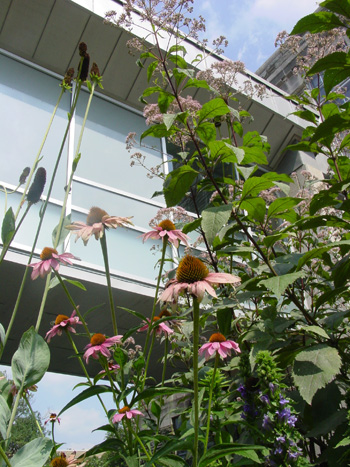 Sue Stark wrote about creating a certified wildlife habitat in her backyard. Until very recently Sue was a Gardener and Volunteer Coordinator at the Scott Arboretum. While she was packing to move with her family to Connecticut, we asked her to take a break and comment on the plants in the Scott Associates Plant Sale that have particular interest for wildlife and conservation.
Sue Stark wrote about creating a certified wildlife habitat in her backyard. Until very recently Sue was a Gardener and Volunteer Coordinator at the Scott Arboretum. While she was packing to move with her family to Connecticut, we asked her to take a break and comment on the plants in the Scott Associates Plant Sale that have particular interest for wildlife and conservation.
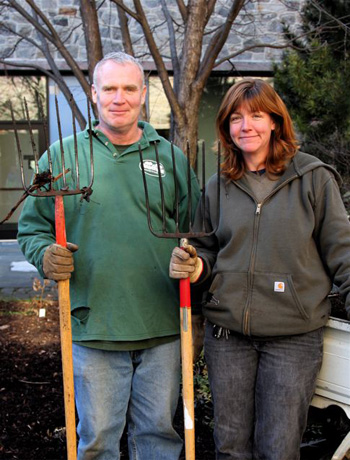
Gardeners, Dwight Darkow and Sue Stark, pose for a whimsical photo. photo credit: D. Mattis
Sue noted, in addition to wildlife benefits, she was interested in plants that establish strongly—that could fill bed spaces, replace lawn, and in particular be an alternative to ivy. In many cases, she gave examples of how the plants have been used around the campus and how they performed.
Here, Sue highlights a few of our birds-and-bees plants, with a focus on ground covers:
Tiarella cordifolia ‘Susquehanna’: This is an example of an ivy replacement. It spreads quickly. Tiarella sp. is said to tolerate a wide range of soil conditions, including alkalinity, which means you can use it near the runoff from a concrete walk or roadway. This is one of the so-called “river series” of foamflower cultivars, named for eastern Pennsylvania rivers. T.c.‘Susquehanna’ is said to have more red in the leaf.
Speaking of ground covers, Waldsteinia ternata, barren strawberry, is also on the sale list. We used the native version, Waldsteinia fragarioides, around the campus as cover under shrubs. Step out of your car in the new Wister Center parking lot and you’ll find it nearby. Walsteinia also works great with spring bulbs. W. ternata clumps more, doesn’t run out as much as our native, and perhaps can take the heat a little better, but either is an attractive cover.
You have to consider the ‘Gro-low’ cultivar of Rhus aromatic, a worthy native ground cover. We use it on campus near Alice Paul Hall, and it takes off. Bees will be busy around the spring flowers, birds are attracted to the berries, and the red-purple fall color is a delight.
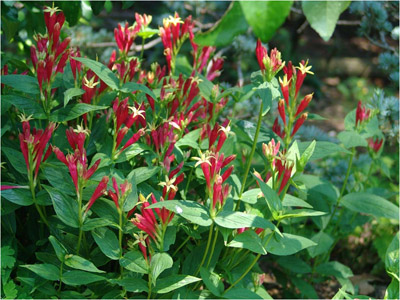
Spigelia Marilandica in bloom. photo credit: Scott Arboretum Archives
Spigelia marilandica is another native perennial worthy of more attention although it is slow to emerge, it’s tough, and has a red flower, which draws the hummingbirds. We use it extensively near the entrance to the Scott Amphitheater.
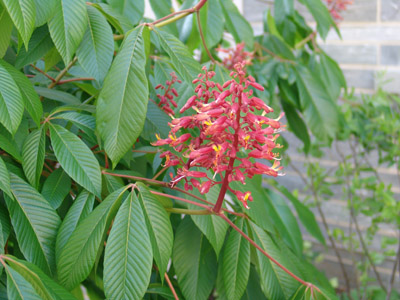
Red flowers of Aesculus pavia. photo credit: R. Pineo
Also of interest to hummingbirds is the red flower of Aesculus pavia, red buckeye. We have ‘Biltmore Strain’ in the sale. It blooms earlier than the bottlebrush buckeye, Aesculus parviflora, and drives the hummingbirds wild. Whether you consider it a shrub or a tree, it will clump out nicely. You can see it used on campus near the Dana/Hollowell dorms.
Back among the perennials, I’ll mention Phlox paniculata ‘Jeana’ on the sale list. Commonly used, the Phlox flower has the attractiveness and attraction-interest of the non-native Buddleja sp., without the drawbacks. This new cultivar has 2 important virtues: it is very mildew resistant, and does not grow as tall as straight species making it less likely to flop.
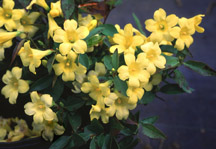
Striking yellow flowers of Gelsemium sempervirens 'Margarita'. photo credit: R. Robert
Finally, we should consider a plant that is not listed as an “East-of-the-Mississippi” native—the Gelsemium sempervirens ‘Margarita’. Commonly called Carolina jasmine, this is a U.S. plant, but is found further south and out of our indigenous area. However, this selection has proven hardy up through zone 6. It has very fragrant, yellow, trumpet-shaped flowers that bring in butterflies and hummingbirds. It’s a vine that can be trellised vertically, or grown horizontally along a fence, or as a groundcover. Plus, it is a Pennsylvania Horticultural Society Gold Medal winner.
You can get complete descriptive and cultural information on the plants Sue mentions from the Plant Sale Handbook.
In addition, note the excerpt listings starting at page 53 in the back of the handbook, the “Plant Suggestions for Specific Needs.” Two categories particularly relate to our discussion here—the Native Plant list and the Winged Wonders list (for bird and pollinators). For your convenience, we’ve reprinted each as one-page lists—Natives here and Winged Wonders here. Read about other great wildlife and conservations recommended by Habitat Steward, Barb Elliot.
==================== >< ===================
Ted Patterson, from Wayne, PA, retired from public relations work with the U.S. Dept. of Agriculture, is a co-chair of the woody plant section at the Scott Associates Plant Sale.





Bryce Hach
Posted at 10:04h, 01 JulyHello,
I am doing work with the Maine Audubon that is looking being spreading the word and training large numbers of people about wildlife habitat gardens. I have been impressed with the information Sue Stark has provided on this subject and I am curious if there might be an opportunity for us to talk over the phone about ways to get large audiences engaged with wildlife habitat gardens, including those who have limited experience or knowledge about this.
Thank you very much and best regards-
Bryce Hach
(970)412-1290
brycehach@gmail.com
Becky Robert
Posted at 10:08h, 01 JulyDear Bryce,
Sue Stark no longer works at the Arboretum, but I have forwarded your note along to her. She will reach out to your directly.
Good luck in your efforts.
Sincerely,
Becky